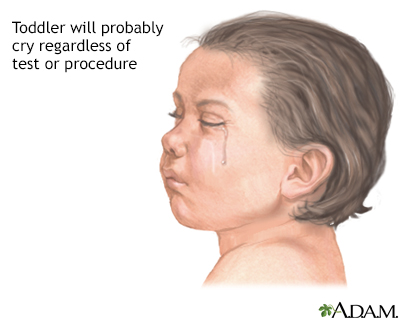Pregnancy SmartSiteTM
Preparing toddler for test/procedure; Test/procedure preparation - toddler; Preparing for a medical test or procedure - toddler DefinitionHelping your young child prepare for a medical test or procedure can reduce anxiety, increase cooperation, and help your child develop coping skills. InformationBefore the test, know that your child will probably cry. Even if you prepare, your child may feel some discomfort or pain. Try using play to show your child what will happen during the test. Doing so may help you learn your child's concerns. The most important way you can help your child is by preparing ahead of time and providing support at the time of the test. PREPARING BEFORE THE PROCEDURE Limit your explanations about the procedure to 5 or 10 minutes. Toddlers have a short attention span. Any preparation should take place right before the test or procedure. Some general guidelines for preparing your child for a test or procedure:
PLAY PREPARATION Play can be a good way to demonstrate the procedure for your child and find out about any anxiety your child may have. Tailor this technique to your child. Most health care facilities for children use play to prepare children for procedures. Many young children have a favorite toy or important object that can be used to explain the test. It may be less threatening for your child to express concerns through the object. For example, a child may be able to understand a blood test if you discuss how the doll might feel during the test. Toys or dolls can also help you explain the procedure to your toddler. These visual examples can take the place of unfamiliar words for younger children with a limited vocabulary. Once you know how the procedure will be done, briefly demonstrate what your child will experience on the toy. Show the body positions the child will be in, where bandages and stethoscopes will be placed, how incisions are made, how injections are given, and how intravenous (IV) lines are inserted. After your explanation, allow your child to play with some of the items (except for needles and other sharp objects). Watch your child for clues about concerns and fears. No matter which test is performed, your child will probably cry. This is a normal response to a strange environment, people they do not know, and being separated from you. Knowing this from the beginning may help relieve some of your anxiety about what to expect. WHY RESTRAINTS? Your child may be restrained by hand or with physical devices. Young children do not have the physical control, coordination, and ability to follow commands that older children and adults usually have. Most tests and procedures require limited or no movement to ensure their accuracy. For example, to get clear x-ray results, the child cannot move. Restraints may also be used to make sure your child is safe during a procedure or other situation. For example, restraints may be used to keep your child safe when staff have to temporarily leave the room during x-ray and nuclear studies. Restraints may also be used to hold your child still while the skin is punctured to obtain a blood sample or start an IV. If your child moves, the needle could cause an injury. Your child's health care provider will do everything possible to make sure your child is safe and comfortable. Depending on the test, medicines to sedate your child may be used. Your job as a parent is to comfort your child. DURING THE PROCEDURE Your presence helps your child during the procedure, especially if the procedure allows you to maintain physical contact. If the procedure is performed at a hospital or at the provider's office, you will most likely be allowed to be there. If you are not sure, ask if you can be there. If you think you may become ill or anxious, consider keeping your distance, but stay where your child can still see you. If you cannot be there, leave a familiar object with your child for comfort. Avoid showing your anxiety. This will only make your child more nervous. Research suggests that children are more cooperative if their parents take measures to reduce their own anxiety. If you are feeling stressed and anxious, consider asking friends and family members for help. They can provide child care for other siblings or meals for the family so you can focus on supporting your child. Other considerations:
ReferencesCancer.org website. Childhood cancer. www.cancer.org/cancer/childhood-cancer.html. Accessed June 2, 2025. Chow CH, Van Lieshout RJ, Schmidt LA, Dobson KG, Buckley N. Systematic review: audiovisual interventions for reducing preoperative anxiety in children undergoing elective surgery. J Pediatr Psychol. 2016;41(2):182-203. PMID: 26476281 pubmed.ncbi.nlm.nih.gov/26476281/. Kain ZN, Fortier MA, Chorney JM, Mayes L. Web-based tailored intervention for preparation of parents and children for outpatient surgery (WebTIPS): development. Anesth Analg. 2015;120(4):905-914. PMID: 25790212 pubmed.ncbi.nlm.nih.gov/25790212/. Lerwick JL. Minimizing pediatric healthcare-induced anxiety and trauma. World J Clin Pediatr. 2016;5(2):143-150. PMID: 27170924 pubmed.ncbi.nlm.nih.gov/27170924/. | ||
| ||
Review Date: 4/17/2024 Reviewed By: Neil K. Kaneshiro, MD, MHA, Clinical Professor of Pediatrics, University of Washington School of Medicine, Seattle, WA. Also reviewed by David C. Dugdale, MD, Medical Director, Brenda Conaway, Editorial Director, and the A.D.A.M. Editorial team. Editorial update 06/02/2025. View References The information provided herein should not be used during any medical emergency or for the diagnosis or treatment of any medical condition. A licensed medical professional should be consulted for diagnosis and treatment of any and all medical conditions. Links to other sites are provided for information only -- they do not constitute endorsements of those other sites. No warranty of any kind, either expressed or implied, is made as to the accuracy, reliability, timeliness, or correctness of any translations made by a third-party service of the information provided herein into any other language. © 1997- A.D.A.M., a business unit of Ebix, Inc. Any duplication or distribution of the information contained herein is strictly prohibited. | ||


 Toddler test
Toddler test
